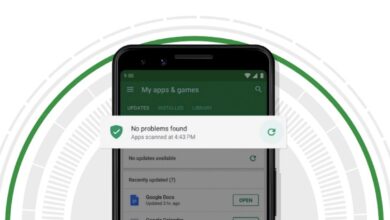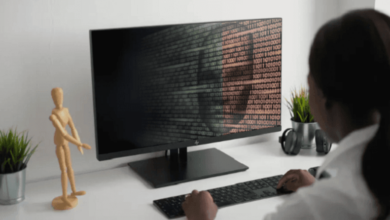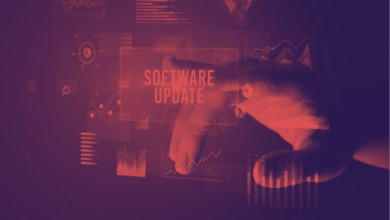
CISA Issues Mobile Security Checklist and Secure Email Plans
CISA issues mobile security checklist and plans for secure email service – sounds dry, right? Wrong! This is actually vital stuff for anyone handling sensitive information on their phone or via email. We’re diving deep into CISA’s recommendations, exploring their practical implications, and looking at how to beef up your mobile and email security. Think of this as your personal guide to staying one step ahead of those pesky cyber threats.
We’ll break down CISA’s checklist for mobile security, covering everything from device hardening to secure network access. Then, we’ll tackle email security, looking at how to set up a secure email configuration and what to do about those ever-present phishing attempts. We’ll even show you how these two areas intertwine – because a weak link in one area can compromise the other.
Get ready to level up your digital defenses!
CISA Mobile Security Checklist
The Cybersecurity and Infrastructure Security Agency (CISA) provides crucial guidance for securing mobile devices, recognizing their increasing role in both personal and professional data access. Their mobile security checklist emphasizes a layered approach, combining device hardening, network security protocols, and robust data protection measures to minimize vulnerabilities and risks. Understanding and implementing these recommendations is paramount for organizations and individuals alike.
Core Principles of CISA’s Mobile Security Recommendations
CISA’s recommendations are founded on the principle of minimizing the attack surface. This involves reducing the potential entry points for malicious actors by strengthening device security, controlling network access, and implementing strong data protection mechanisms. The agency stresses a proactive approach, emphasizing preventative measures over reactive incident response. This includes regular updates, proactive threat monitoring, and robust security awareness training for users.
The underlying philosophy is to build a resilient mobile security posture that can withstand a range of threats.
Specific Security Controls for Mobile Devices Accessing Sensitive Data
For mobile devices handling sensitive data, CISA advocates for a multi-faceted approach. This includes strong authentication methods like multi-factor authentication (MFA), device encryption both at rest and in transit, and regular software updates to patch known vulnerabilities. Remote wipe capabilities are crucial in case of loss or theft, allowing for the immediate deletion of sensitive data. Access controls, limiting functionality based on user roles and permissions, further restrict unauthorized access.
Regular security assessments and penetration testing are also recommended to identify and address potential weaknesses before they can be exploited. CISA specifically highlights the importance of using only approved applications from trusted sources, thereby reducing the risk of malware infiltration.
Comparison of CISA’s Checklist with Industry Best Practices
CISA’s mobile security checklist aligns closely with industry best practices established by organizations like NIST and SANS. Many of the recommendations, such as strong password policies, regular software updates, and data encryption, are common across multiple frameworks. However, CISA’s checklist provides a more focused and actionable approach tailored specifically to the unique challenges of mobile device security. It emphasizes practical implementation steps, offering clear guidance on how to achieve a secure mobile environment.
While other frameworks may provide a broader overview, CISA’s checklist is designed to be easily implemented and monitored, making it particularly valuable for organizations with limited security resources.
Summary of Key CISA Mobile Security Checklist Points
| Security Domain | Key Recommendation | Security Domain | Key Recommendation |
|---|---|---|---|
| Device Security | Enable device encryption | Network Security | Use a VPN for secure network connections |
| Device Security | Install and maintain the latest OS updates | Network Security | Restrict access to public Wi-Fi networks |
| Data Security | Implement strong password policies | Data Security | Use mobile device management (MDM) solutions |
| Data Security | Enable remote wipe capabilities | Device Security | Utilize multi-factor authentication (MFA) |
Secure Email Service

So, we’ve tackled mobile security, and now it’s time to dive into another critical area: securing our email communications. Email remains a primary attack vector for cybercriminals, so a robust security strategy is absolutely vital. CISA (Cybersecurity and Infrastructure Security Agency) provides excellent guidance on this front, and we’ll explore their key recommendations here.
CISA’s approach to email security emphasizes a multi-layered defense, encompassing both the email client and the server infrastructure. It’s not just about technology; it’s about implementing strong policies and educating users. Let’s examine how this works in practice.
CISA’s Recommendations for Securing Email Services
CISA’s recommendations cover a broad spectrum of security controls, from basic hygiene to advanced encryption techniques. They stress the importance of regularly updating software, implementing strong authentication methods, and employing robust encryption protocols. Their guidance is designed to protect against a range of threats, from phishing attacks to data breaches. The focus is on minimizing vulnerabilities and maximizing resilience.
Secure Email Configuration Based on CISA Guidelines, Cisa issues mobile security checklist and plans for secure email service
Let’s imagine a hypothetical, yet realistic, secure email configuration adhering to CISA best practices. We’ll use a combination of technologies and policies. The email server would be hardened, patched regularly, and monitored for suspicious activity. Multi-factor authentication (MFA) would be mandatory for all users, ideally using a strong, time-based one-time password (TOTP) method. Email encryption would be enabled by default using TLS (Transport Layer Security) for all outgoing and incoming mail.
Access controls would be granular, with users only having access to the information they need. Furthermore, a robust spam filtering system and an anti-malware solution would be in place to filter out malicious emails before they reach the inbox. Regular security audits and penetration testing would be conducted to identify and address vulnerabilities proactively.
Common Email Security Vulnerabilities and CISA’s Mitigation Strategies
Phishing attacks, for instance, often exploit weak passwords and a lack of user awareness. CISA’s recommendation of MFA significantly mitigates this risk, as even if a password is compromised, the attacker still needs access to the second authentication factor. Another common vulnerability is the use of unencrypted email, leaving sensitive data exposed. CISA’s emphasis on TLS encryption addresses this directly, ensuring confidentiality and integrity.
Finally, outdated email clients and servers represent a significant risk, as they often contain known vulnerabilities. CISA’s advice on regular patching and updates directly combats this threat.
Best Practices for Email Security Awareness Training
A strong security posture requires not only robust technology but also well-informed users. CISA’s guidance on security awareness training is critical. Here are some key best practices:
Effective email security awareness training should be engaging and regularly reinforced. It’s not a one-time event but an ongoing process.
- Regular training sessions covering phishing scams, malware, and social engineering techniques.
- Interactive modules and simulations to help users identify and respond to suspicious emails.
- Emphasis on strong password management and the importance of MFA.
- Clear guidelines on handling sensitive information via email, including the use of encryption when necessary.
- Reporting mechanisms for suspicious emails and security incidents.
- Regular phishing tests to assess user awareness and identify vulnerabilities.
Integrating Mobile Security and Email Security
Mobile devices have become indispensable tools for communication and productivity, blurring the lines between personal and professional life. This integration, however, introduces significant security challenges, especially concerning email. Strong security practices must encompass both mobile device management and secure email protocols to effectively mitigate these risks. Failure to do so leaves organizations vulnerable to data breaches, phishing attacks, and other cyber threats.The security of email on mobile devices is intrinsically linked to the security of the device itself.
A compromised mobile device provides a direct pathway to sensitive information contained within emails, regardless of how secure the email system itself is. Conversely, even with robust email security measures, a poorly secured device can negate these efforts, making the entire system vulnerable. This interdependency necessitates a holistic approach to security, encompassing both aspects.
Potential Security Risks of Email on Mobile Devices
Using email on mobile devices introduces several vulnerabilities. CISA guidance highlights the risks associated with unpatched operating systems, weak or easily guessable passwords, lack of device encryption, and the use of unsecured Wi-Fi networks. These factors, combined with the potential for malware infections through malicious attachments or links within emails, create a significant attack surface. The portability of mobile devices also increases the risk of loss or theft, potentially exposing sensitive data.
Moreover, the use of personal devices for work (BYOD) introduces additional complexities and risks, requiring stringent policies and controls.
CISA’s new mobile security checklist and secure email service plans are crucial, especially considering the rise in mobile threats. Building robust, secure apps is key, and that’s where understanding the evolving landscape of application development comes in – check out this great article on domino app dev the low code and pro code future to see how modern approaches can help.
Ultimately, strong app security, combined with CISA’s guidelines, is essential for a truly protected digital environment.
Strengthening Mobile Device Security to Enhance Email Security
Implementing strong mobile device security measures significantly improves the overall security posture of email communications. This includes regularly updating the operating system and applications, using strong, unique passwords, enabling device encryption, and utilizing multi-factor authentication (MFA) wherever possible. Employing mobile device management (MDM) solutions allows organizations to enforce security policies, remotely wipe lost or stolen devices, and monitor device activity for suspicious behavior.
Regular security awareness training for users is also crucial to educate them about phishing attacks, malware, and other threats. Restricting access to corporate email to approved devices and enforcing strong password policies, coupled with regular software updates, forms a robust defense against many common threats.
Secure Communication Path: Email Server to Mobile Device
The following describes a secure communication path from the email server to the mobile device. Imagine a user accessing their email on their smartphone.
The process begins at the email server, where data is encrypted using TLS/SSL. This encrypted data is then transmitted over a secure network connection (e.g., a VPN if accessing from an untrusted network) to the mobile device. The mobile device, protected by a strong password and encryption, decrypts the data using its private key. Throughout this process, MFA might be employed at various stages to verify user identity.
Finally, the email client application on the mobile device displays the decrypted email content. Regular security updates to the email client, operating system, and network infrastructure are crucial for maintaining the integrity of this security chain.
This process can be visualized as a flowchart. Each step would be a box, and the arrows connecting them would represent the data flow. The boxes would label each step: Email Server (TLS/SSL Encryption), Secure Network Connection (VPN if needed), Mobile Device (Decryption with Private Key and OS Security), Email Client Application (Secure Display). Each box would also indicate the security controls involved at that stage, such as encryption protocols, authentication methods, and software updates.
Addressing Specific Threats: Cisa Issues Mobile Security Checklist And Plans For Secure Email Service

CISA’s approach to mobile and email security focuses on proactive threat mitigation and reactive incident response. Understanding the specific threats and CISA’s recommended countermeasures is crucial for maintaining a secure digital environment. This section details CISA’s guidance on addressing phishing attacks, malware, and compromised accounts, along with a comparison of authentication methods.
CISA’s new mobile security checklist and secure email service plans are crucial, especially considering the increasing reliance on cloud services. Understanding how to effectively manage this expanded attack surface is key, and that’s where solutions like Bitglass come in; check out this great article on bitglass and the rise of cloud security posture management to learn more.
Ultimately, strong mobile security and secure email practices, informed by resources like CISA’s guidelines, are essential for a robust overall security posture.
CISA’s Approach to Phishing Attacks
Phishing attacks, targeting both mobile devices and email accounts, remain a significant threat. CISA emphasizes user education as the first line of defense. This includes training users to identify suspicious emails and messages, such as those with unusual formatting, grammar errors, or urgent requests for personal information. For mobile devices, this extends to being cautious about clicking links in SMS messages or downloading apps from untrusted sources.
CISA also recommends implementing technical controls, such as email filtering and anti-phishing software, to block malicious emails and links before they reach users. Regular security awareness training, reinforced with simulated phishing campaigns, helps users stay vigilant and recognize phishing attempts.
Examples of Malware Targeting Mobile Devices and Email
Mobile malware can range from spyware that steals personal data to ransomware that encrypts files and demands a ransom. Examples include banking trojans that intercept financial transactions and adware that displays unwanted advertisements. Email-borne malware often arrives as attachments or links within phishing emails. These attachments can be malicious executables or documents containing macros that execute harmful code.
CISA recommends using robust antivirus and anti-malware software on both mobile devices and email servers. Regular software updates are also essential to patch known vulnerabilities exploited by malware. Implementing sandboxing techniques to isolate potentially malicious files before execution is another effective countermeasure.
Detecting and Responding to Compromised Accounts
CISA advises establishing robust monitoring and detection mechanisms to identify compromised mobile devices or email accounts. This includes regular security audits, intrusion detection systems, and user behavior analytics. Unusual login attempts from unfamiliar locations or devices, unexpected changes in account settings, and unauthorized access to sensitive data are all potential indicators of compromise. In the event of a compromise, CISA recommends immediately changing passwords, revoking access to compromised accounts, and notifying relevant authorities.
A thorough investigation should be conducted to determine the extent of the breach and implement appropriate remediation measures. Data backups are crucial for restoring data in case of data loss due to malware or account compromise.
Authentication Method Comparison
| Authentication Method | Description | Effectiveness | CISA Recommendations |
|---|---|---|---|
| Passwords | A secret code used to verify identity. | Low (easily guessable, susceptible to phishing) | Use strong, unique passwords and encourage password managers. |
| Multi-Factor Authentication (MFA) | Requires multiple authentication factors (e.g., password + one-time code). | High (significantly reduces unauthorized access) | Mandate MFA for all sensitive accounts. Use a variety of MFA methods. |
| Biometrics | Uses unique biological characteristics (e.g., fingerprint, facial recognition). | Medium to High (depends on implementation and security) | Implement robust biometric authentication systems with appropriate security measures. |
| Hardware Security Keys | Physical devices that generate cryptographic keys. | High (very secure, resistant to phishing and malware) | Highly recommended for high-value accounts. |
Implementation and Ongoing Management
Successfully implementing CISA’s mobile security and secure email recommendations requires a phased approach, combining technical configurations with robust employee training and ongoing monitoring. Ignoring any of these aspects leaves significant vulnerabilities. A well-defined implementation plan, coupled with a commitment to continuous improvement, is crucial for maintaining a secure digital environment.Implementing CISA’s recommendations involves a multi-step process. First, a thorough risk assessment should identify vulnerabilities specific to your organization’s mobile devices and email systems.
This assessment informs the prioritization of security controls. Next, the technical implementation begins: this includes configuring mobile device management (MDM) solutions, enforcing strong password policies, implementing multi-factor authentication (MFA), and deploying secure email gateways. Finally, regular testing and updates are vital to maintain the effectiveness of these controls. The entire process requires collaboration between IT, security, and end-users.
Mobile Device and Email Security Implementation Steps
Implementing CISA’s guidelines requires a systematic approach. This involves several key steps: defining a clear mobile device policy outlining acceptable use, device security requirements (e.g., passcodes, encryption), and data handling procedures. Then, deploy and configure an MDM solution to enforce these policies. Simultaneously, implement secure email practices, including enabling SPF, DKIM, and DMARC to prevent email spoofing and phishing attacks.
Regular security audits and vulnerability scans are essential to identify and remediate weaknesses. Finally, integrate security awareness training to empower employees to recognize and avoid security risks.
Regular Security Audits and Vulnerability Assessments
Regular security audits and vulnerability assessments are not simply best practices; they’re essential for maintaining a secure environment. Think of them as regular check-ups for your digital health. These assessments uncover hidden weaknesses in your security posture, allowing for proactive mitigation before they can be exploited by attackers. For instance, a recent audit might reveal outdated software on employee mobile devices, leaving them susceptible to known vulnerabilities.
Addressing these issues promptly prevents potential data breaches and system compromises. The frequency of these assessments should depend on your risk tolerance and the sensitivity of the data handled. A yearly audit, coupled with more frequent vulnerability scans, is a reasonable starting point for most organizations.
Ongoing Security Awareness Training Plan
A comprehensive security awareness training program is critical for mitigating human error, a major source of security breaches. This program should be ongoing, not a one-time event. Regular training sessions should cover topics like phishing awareness, password security, recognizing and reporting suspicious emails, and safe mobile device usage. The training should be engaging and tailored to different employee roles and technical skills.
Simulations, like mock phishing campaigns, are effective in reinforcing learning and identifying vulnerabilities in employee awareness. Consider using a blended learning approach, combining online modules with in-person workshops and regular email reminders.
Mobile Device and Email Security Incident Response Checklist
It’s not a matter of
- if* a security incident will occur, but
- when*. Having a clear and concise incident response plan is crucial. This plan should detail the steps to take when a mobile device is lost or compromised, or when a suspicious email is received.
- Identify the incident: Determine the nature and scope of the incident (e.g., phishing email, lost device, malware infection).
- Contain the breach: Immediately isolate affected devices and accounts to prevent further damage.
- Eradicate the threat: Remove malware, reset passwords, and remediate vulnerabilities.
- Recover systems: Restore data and services to their operational state.
- Post-incident analysis: Conduct a thorough review to identify root causes and improve security measures.
- Documentation: Maintain detailed records of the incident, response actions, and lessons learned.
End of Discussion
So, there you have it – a practical look at CISA’s recommendations for mobile and email security. Implementing these measures isn’t just about ticking boxes; it’s about proactively protecting your sensitive data and maintaining a robust security posture. Remember, staying informed and adapting your strategies to evolving threats is key. Don’t just react to breaches – prevent them! Go forth and secure your digital world!
Essential FAQs
What are the penalties for non-compliance with CISA guidelines?
Penalties vary depending on the industry, regulations, and the severity of the breach. Non-compliance can lead to fines, legal action, reputational damage, and loss of customer trust.
How often should I update my mobile security checklist?
Regularly, ideally aligning with CISA updates and software patch releases. At least annually, or more frequently if significant changes occur in your organization or technology.
Can CISA’s recommendations be applied to personal use?
Many of CISA’s recommendations are applicable to personal use, offering a solid framework for enhancing your individual online security.
What if my organization doesn’t have the resources to fully implement CISA’s recommendations?
Prioritize implementing the most critical recommendations first, focusing on areas with the highest risk. Gradually implement others as resources allow. Consider seeking external cybersecurity assistance.





